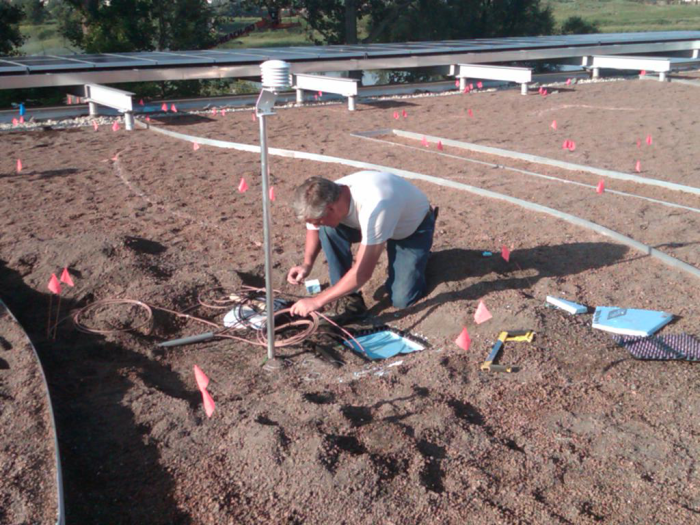




385 エーカーの広さを誇るシカゴ植物園には、毎年 75 万人を超える来園者が訪れます。新設のダニエル F. およびエイダ L. ライス プラント サイエンス センターは、博士号取得科学者、土地管理者、学生、インターンシップ生など 200 人以上の研究者に研究室と教育施設を提供しています。
植物科学センターは、米国グリーン ビルディング協会のエネルギーと環境デザインにおけるリーダーシップ (LEED) のゴールド評価を取得するために設計されました。植物園組織の植物研究への取り組みと、実用的な利点と公共教育を追加したいという願いを組み合わせて、センターの屋上 16,000 平方フィートが緑の屋上庭園として建設されました。
屋上庭園は、建物の断熱効果を高め、日光を吸収することで、建物の冷却要件を低下させ、建物に恩恵をもたらします。また、雨水の流出を捕らえて保持し、庭園の散水に利用することもできます。庭園は研究施設として機能するため、シカゴ植物園のプログラム側にも恩恵をもたらします。そこでスタッフは、どの植物が屋上庭園に適しているかを調べるために植物を研究することができます。
この屋上実験室にはさまざまなセンサーが装備されており、以下のものを監視します。
- 屋根デッキ直下の室内空気温度
- 土壌上および中二階屋根上の屋外空気温度
- さまざまな深さと屋根断熱材の土壌温度
- 土壌熱流束
- 日射
- 中二階屋根上の湿度と風
- 降水量
37 年のモニタリング経験を持つ Adams Environmental Systems は、建設会社および庭園の科学者と提携して、この大規模なシステムを設計しました。50 個を超えるセンサーを設置し、3 台の Campbell Scientific データ ロガーと 2 台の AM25T マルチプレクサを使用してデータを収集および送信しました。
Adams Environmental 社は、庭のさまざまな場所に 2 つの CR800 データロガーを設置し、それらを屋上の機器室の CR1000 に接続する構成を設計することで、各センサーから屋上を 1 つのデータロガーまでケーブルを配線する必要がなくなりました。これにより、追加の導管とそれを設置するための人件費を除いて、システム ケーブルのコストだけで 8,000 ドル以上を節約できました。
CR1000 データロガーは建物のイーサネット ネットワークに接続され、キャンベルの LoggerNet ソフトウェアがデータを収集します。研究者は生成された情報を分析することで、さまざまなタイプの屋上庭園の利点を判断できます。また、異なる土壌層の厚さ、異なる水の量、そしてプログラムにとって最も重要な、異なる種類の植物の結果を比較することもできます。利用できるデータが大量にあるため、屋上庭園の設計者は、他の庭園に取り組む際にこれらの実験から学ぶことができます。シカゴ植物園で言われているように、「植物を救おう。地球を救おう」です。